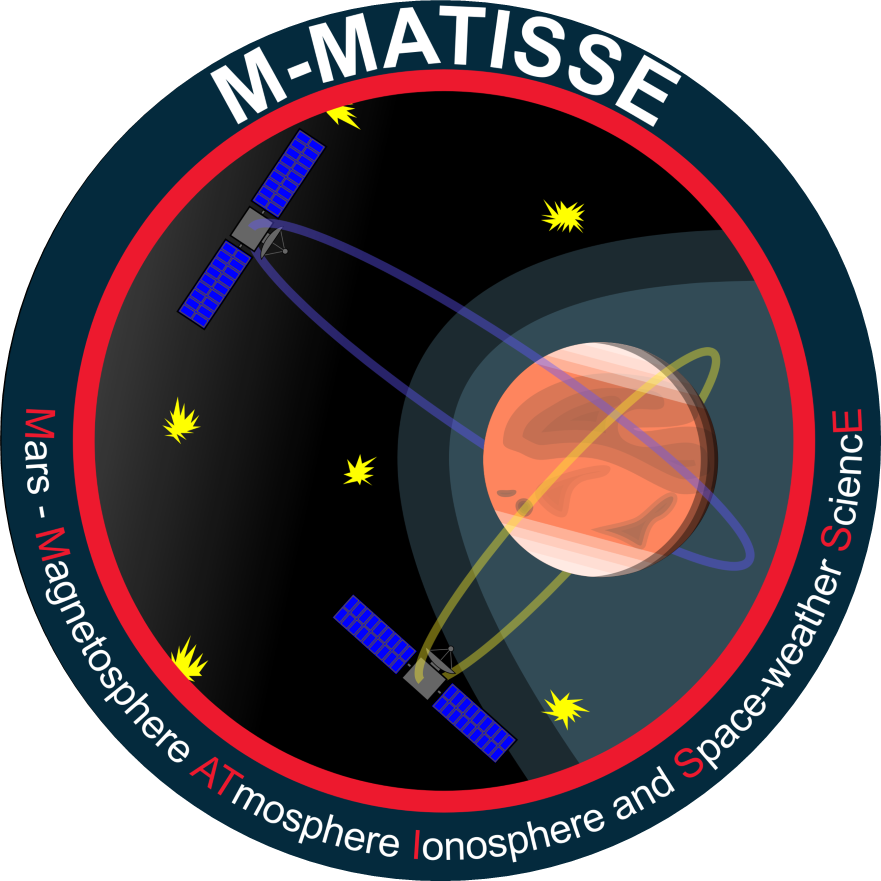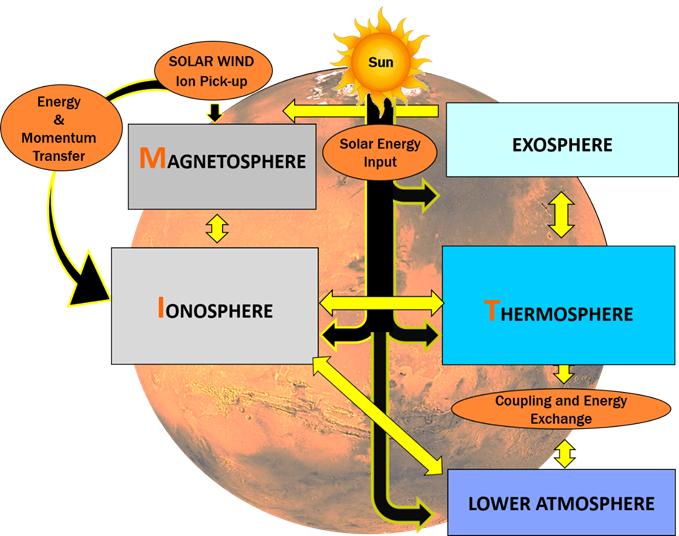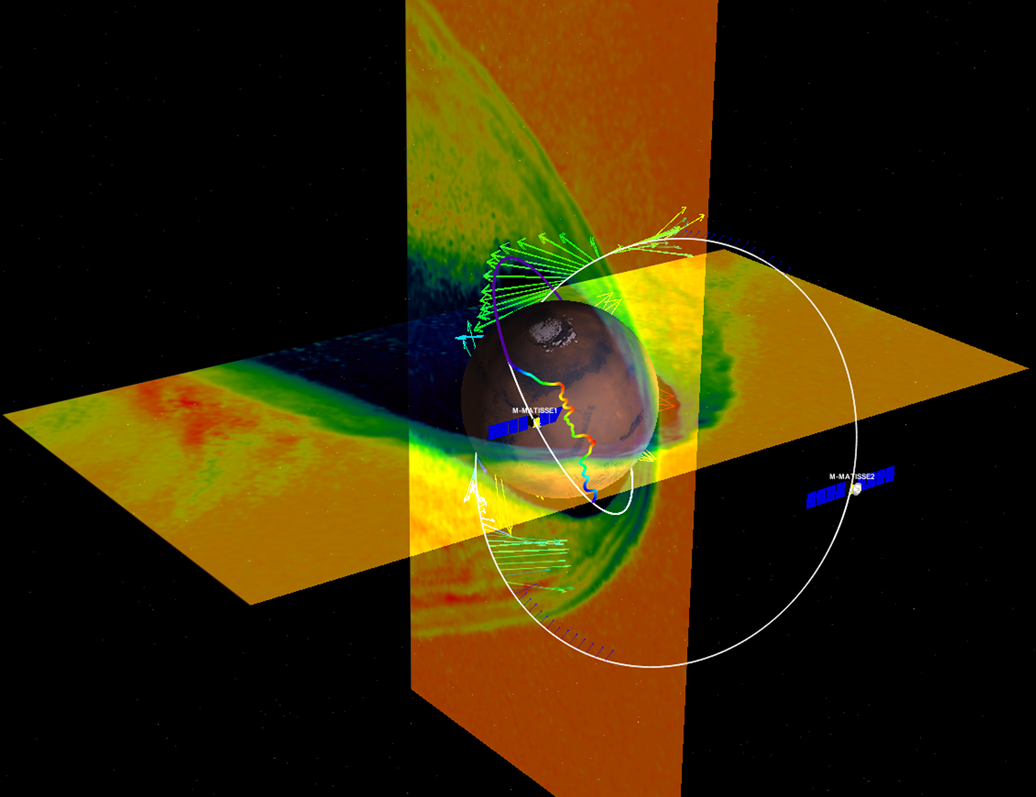The M-MATISSE mission: Mars Magnetosphere ATmosphere Ionosphere and Space weather SciencE. An ESA Medium class (M7) candidate in Phase-A.
- 1University of Leicester, School of Physics and Astronomy, Physics and Astronomy, Leicester, United Kingdom of Great Britain – England, Scotland, Wales (bscmdr1@le.ac.uk)
- 2LATMOS/IPSL, UPMC University Paris 06 Sorbonne Universités, UVSQ, CNRS, Paris, France
- *A full list of authors appears at the end of the abstract
The “Mars Magnetosphere ATmosphere Ionosphere and Space-weather SciencE (M-MATISSE)” mission is an ESA Medium class (M7) candidate currently in Phase A study by the European Space Agency (ESA) (Figure 1). M-MATISSE’s main scientific goal is to unravel the complex and dynamic couplings of the Martian Magnetosphere, Ionosphere and Thermosphere (M-I-T coupling) with relation to the Solar Wind (i.e. space weather) and the lower atmosphere, and the processes leading to this coupling, which are highly entangled between several regions of the system (Figure 2). The M-I-T coupling controls the dissipation of incoming energy from the solar wind, and therefore, the evolution of Mars’ atmosphere and climate (including atmospheric escape, auroral processes, and incoming radiation). Moreover, understanding the behavior of Mars’ M-I-T system and of the chain of processes that control Space Weather and Space Climate at Mars, as well as the radiation environment, is essential for exploration as it leads to accurate Space Weather forecasts and, thus, prevents hazardous situations for spacecraft and humans.

Figure 1: The “Mars Magnetosphere ATmosphere Ionosphere and Space-weather SciencE (M-MATISSE)” mission is an ESA Medium class (M7) candidate.
Mission goals: The mission has three main goals:
- Characterising the global dynamics of the M-I-T coupling by unravelling its temporal and spatial variabilities. This will be done with simultaneous observations of the solar wind (energy input) and ionosphere-magnetosphere (energy sink), and also, via investigating the coupling of the mesosphere with the ionosphere and solar energetic particles.
- Characterising the Radiation environment, by determining how the M-I-T absorbs the energy that reaches the planet and forecasting near-real time planetary Space Weather
- Characterising the Ionosphere-lower atmosphere coupling, which is a region barely explored but essential for solar energetic particles related phenomena as well as for communications in the HF wavelengths.
In addition, M-MATISSE will significantly contribute to understand Mars climate and the lower atmosphere as two remote instruments have dedicated instrumentation to monitor dust, clouds, and get temperature and density profiles from the surface up to about 50 km. Moreover, the heliophysics community will count with a full-package solar wind monitor at Mars’ distances, contributing to understand solar wind and solar transient propagation in the inner Solar System.

Figure 2: Mars regions that M-MATISSE will focus to understand the spatial-temporal variability of the M-I-T system and its couplings from the surface to space.
Type of Mission: M-MATISSE is one of the current three candidates in competition at ESA at the Medium-size opportunity in ESA's Science Programme from the call in December 2021. From 27 initial responses, ESA down-selected 5 missions in 2022, which went through a Phase 0 study. In that phase, ESA evaluated the expected science that could be achieved with each mission, as well as came up with a preliminary mission design. In November 2023, ESA further down-selected them to three, which are currently in Phase A studies. In this phase, each candidate mission will be studied in detail by ESA, involving European aerospace companies, national institutes, and universities, resulting in a more comprehensive design for each mission. Payload maturation activities are being performed in parallel including breadboarding and test. It is expected that one candidate mission will be chosen by mid-2026.

Figure 3: Simulation of the Martian plasma system and the two M-MATISSE spacecraft with their nominal orbits.
M-MATISSE mission concept: M-MATISSE consists of two orbiters with focused, tailored, high-heritage payloads to observe the plasma environment from the surface to space through coordinated simultaneous observations. It will utilize a unique multi-vantage point observational perspective, with the combination of in-situ measurements by both orbiters and remote observations of the lower atmosphere and ionosphere by radio crosstalk between them (Figure 3).
The fathership, called Henri, has a periapsis below 270 km and an apoapsis of 3000 km with an inclination of 60°, and is intended to spend most of its time within the Martian plasma system. The daughtership, called Marguerite, also has an inclination of 60°, a periapsis below 270 km and an apoapsis of 10,000 km, and is intended to spend most of its time in the solar wind and/or far tail of Mars (a region barely explored before).
M-MATISSE has a nominal mission duration of 1 Martian a year, and the launch date is identified for July 2037.
Consortium: M-MATISSE is the product of a large organized and experienced international consortium in which 15 different space agencies participate. M-MATISSE is a community-led mission, and a legacy concept from pioneer missions, such as Mars Express, Trace Gas Orbiter, MAVEN and experienced teams.
Take home message: M-MATISSE has the unique capability to track solar perturbations from the Solar Wind down to the surface, being the first mission fully dedicated to understand planetary space weather at Mars. It will revolutionize our understanding and ability to forecast potential global hazard situations at Mars, an essential precursor to any future robotic & human exploration.
Acknowledgments: We acknowledge the ESA M-MATISSE CDF team who supported the assessment phase until MDR and the ESA study team, who is managing the Phase A/B1 activities (point of contact robert.buchwald@esa.int). The Science Study Team is managed by Olivier Witasse as M-MATISSE study scientist.
The M-MATISSE science core team is formed by: Beatriz Sanchez-Cano, Francois Leblanc, David Andrews, Nicolas Andre, Alessandra Barco, Jean-yves Chaufray, Andrew Coates, Raffaella D'Amicis, Pierre Devoto, Marie Dominique, Johan De Keyser, Yoshifumi Futaana, Philippe Garnier, Vincent Genot, Jean-Claude Gerard, Lina Hadid, Takuya Hara, Yuki Harada, Pierre Henri, Sonal Jain, Gunter Laky, Mark Lester, Michael Liemohn, Ronan Modolo, Hiromu Nakagawa, Yuki Nakamura, Frantisek Nemec, Janusz Oschlisniok, Martin Pätzold, Kerstin Peter, David Pisa, Ferdinand Plaschke, Lubomir Prech, Jim Raines, Hanna Rothkaehl, Shotaro Sakai, Nick Schneider, Lauriance Soret, Štěpán Štverák, Naoki Terada, Silvia Tellmann, Ed Thieman, Daniel Verscharen, Tom Woods, Shoichiro Yokota, Louise Harra, Silvio Koller, Valeria Buechel, Yuki Nakamura, Sae Aizawa
How to cite: Sanchez-Cano, B. and Leblanc, F. and the The M-MATISSE team: The M-MATISSE mission: Mars Magnetosphere ATmosphere Ionosphere and Space weather SciencE. An ESA Medium class (M7) candidate in Phase-A. , Europlanet Science Congress 2024, Berlin, Germany, 8–13 Sep 2024, EPSC2024-545, https://doi.org/10.5194/epsc2024-545, 2024.